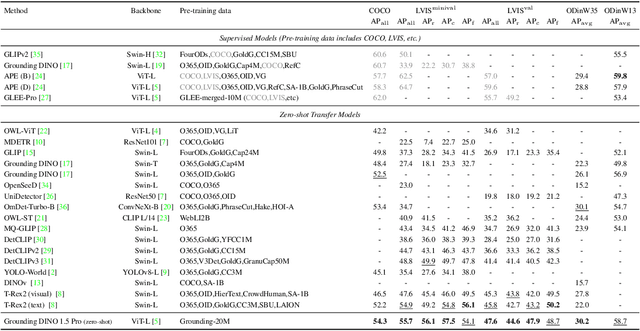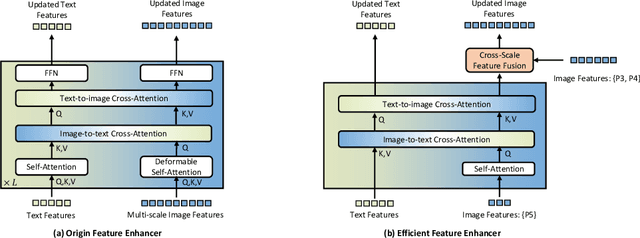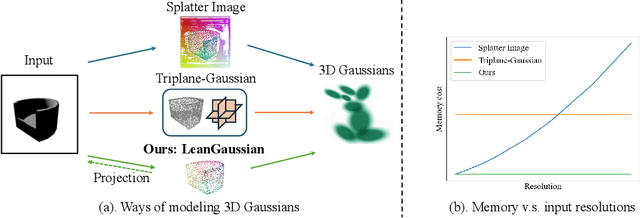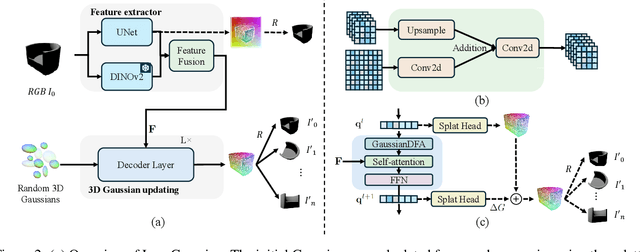Han Gao
Adaptive Interactive Navigation of Quadruped Robots using Large Language Models
Mar 29, 2025Abstract:Robotic navigation in complex environments remains a critical research challenge. Traditional navigation methods focus on optimal trajectory generation within free space, struggling in environments lacking viable paths to the goal, such as disaster zones or cluttered warehouses. To address this gap, we propose an adaptive interactive navigation approach that proactively interacts with environments to create feasible paths to reach originally unavailable goals. Specifically, we present a primitive tree for task planning with large language models (LLMs), facilitating effective reasoning to determine interaction objects and sequences. To ensure robust subtask execution, we adopt reinforcement learning to pre-train a comprehensive skill library containing versatile locomotion and interaction behaviors for motion planning. Furthermore, we introduce an adaptive replanning method featuring two LLM-based modules: an advisor serving as a flexible replanning trigger and an arborist for autonomous plan adjustment. Integrated with the tree structure, the replanning mechanism allows for convenient node addition and pruning, enabling rapid plan modification in unknown environments. Comprehensive simulations and experiments have demonstrated our method's effectiveness and adaptivity in diverse scenarios. The supplementary video is available at page: https://youtu.be/W5ttPnSap2g.
Learning Effective Dynamics across Spatio-Temporal Scales of Complex Flows
Feb 11, 2025Abstract:Modeling and simulation of complex fluid flows with dynamics that span multiple spatio-temporal scales is a fundamental challenge in many scientific and engineering domains. Full-scale resolving simulations for systems such as highly turbulent flows are not feasible in the foreseeable future, and reduced-order models must capture dynamics that involve interactions across scales. In the present work, we propose a novel framework, Graph-based Learning of Effective Dynamics (Graph-LED), that leverages graph neural networks (GNNs), as well as an attention-based autoregressive model, to extract the effective dynamics from a small amount of simulation data. GNNs represent flow fields on unstructured meshes as graphs and effectively handle complex geometries and non-uniform grids. The proposed method combines a GNN based, dimensionality reduction for variable-size unstructured meshes with an autoregressive temporal attention model that can learn temporal dependencies automatically. We evaluated the proposed approach on a suite of fluid dynamics problems, including flow past a cylinder and flow over a backward-facing step over a range of Reynolds numbers. The results demonstrate robust and effective forecasting of spatio-temporal physics; in the case of the flow past a cylinder, both small-scale effects that occur close to the cylinder as well as its wake are accurately captured.
Progressive Boundary Guided Anomaly Synthesis for Industrial Anomaly Detection
Dec 23, 2024Abstract:Unsupervised anomaly detection methods can identify surface defects in industrial images by leveraging only normal samples for training. Due to the risk of overfitting when learning from a single class, anomaly synthesis strategies are introduced to enhance detection capability by generating artificial anomalies. However, existing strategies heavily rely on anomalous textures from auxiliary datasets. Moreover, their limitations in the coverage and directionality of anomaly synthesis may result in a failure to capture useful information and lead to significant redundancy. To address these issues, we propose a novel Progressive Boundary-guided Anomaly Synthesis (PBAS) strategy, which can directionally synthesize crucial feature-level anomalies without auxiliary textures. It consists of three core components: Approximate Boundary Learning (ABL), Anomaly Feature Synthesis (AFS), and Refined Boundary Optimization (RBO). To make the distribution of normal samples more compact, ABL first learns an approximate decision boundary by center constraint, which improves the center initialization through feature alignment. AFS then directionally synthesizes anomalies with more flexible scales guided by the hypersphere distribution of normal features. Since the boundary is so loose that it may contain real anomalies, RBO refines the decision boundary through the binary classification of artificial anomalies and normal features. Experimental results show that our method achieves state-of-the-art performance and the fastest detection speed on three widely used industrial datasets, including MVTec AD, VisA, and MPDD. The code will be available at: https://github.com/cqylunlun/PBAS.
Path Tracking Hybrid A* For Autonomous Agricultural Vehicles
Nov 21, 2024Abstract:We propose a path-tracking Hybrid A* planner and a coupled hierarchical Model Predictive Control (MPC) controller in scenarios involving the path smoothing of agricultural vehicles. For agricultural vehicles following reference paths on farmlands, especially during cross-furrow operations, a minimum deviation from the reference path is desired, in addition to the curvature constraints and body scale collision avoidance. Our contribution is threefold. (1) We propose the path-tracking Hybrid A*, which satisfies nonholonomic constraints and vehicle size collision avoidance, and devise new cost and heuristic functions to minimize the deviation degree. The path-tracking Hybrid A* can not only function in offline smoothing but also the real-time adjustment when confronted with unexpected obstacles. (2) We propose the hierarchical MPC to safely track the smoothed trajectory, using the initial solution solved by linearized MPC and nonlinear local adjustments around the initial solution. (3) We carry out extensive simulations with baseline comparisons based on real-world farm datasets to evaluate the performance of our algorithm.
DINO-X: A Unified Vision Model for Open-World Object Detection and Understanding
Nov 21, 2024



Abstract:In this paper, we introduce DINO-X, which is a unified object-centric vision model developed by IDEA Research with the best open-world object detection performance to date. DINO-X employs the same Transformer-based encoder-decoder architecture as Grounding DINO 1.5 to pursue an object-level representation for open-world object understanding. To make long-tailed object detection easy, DINO-X extends its input options to support text prompt, visual prompt, and customized prompt. With such flexible prompt options, we develop a universal object prompt to support prompt-free open-world detection, making it possible to detect anything in an image without requiring users to provide any prompt. To enhance the model's core grounding capability, we have constructed a large-scale dataset with over 100 million high-quality grounding samples, referred to as Grounding-100M, for advancing the model's open-vocabulary detection performance. Pre-training on such a large-scale grounding dataset leads to a foundational object-level representation, which enables DINO-X to integrate multiple perception heads to simultaneously support multiple object perception and understanding tasks, including detection, segmentation, pose estimation, object captioning, object-based QA, etc. Experimental results demonstrate the superior performance of DINO-X. Specifically, the DINO-X Pro model achieves 56.0 AP, 59.8 AP, and 52.4 AP on the COCO, LVIS-minival, and LVIS-val zero-shot object detection benchmarks, respectively. Notably, it scores 63.3 AP and 56.5 AP on the rare classes of LVIS-minival and LVIS-val benchmarks, both improving the previous SOTA performance by 5.8 AP. Such a result underscores its significantly improved capacity for recognizing long-tailed objects.
Generative Learning of the Solution of Parametric Partial Differential Equations Using Guided Diffusion Models and Virtual Observations
Jul 31, 2024



Abstract:We introduce a generative learning framework to model high-dimensional parametric systems using gradient guidance and virtual observations. We consider systems described by Partial Differential Equations (PDEs) discretized with structured or unstructured grids. The framework integrates multi-level information to generate high fidelity time sequences of the system dynamics. We demonstrate the effectiveness and versatility of our framework with two case studies in incompressible, two dimensional, low Reynolds cylinder flow on an unstructured mesh and incompressible turbulent channel flow on a structured mesh, both parameterized by the Reynolds number. Our results illustrate the framework's robustness and ability to generate accurate flow sequences across various parameter settings, significantly reducing computational costs allowing for efficient forecasting and reconstruction of flow dynamics.
Video Coding with Cross-Component Sample Offset
Jun 03, 2024Abstract:Beyond the exploration of traditional spatial, temporal and subjective visual signal redundancy in image and video compression, recent research has focused on leveraging cross-color component redundancy to enhance coding efficiency. Cross-component coding approaches are motivated by the statistical correlations among different color components, such as those in the Y'CbCr color space, where luma (Y) color component typically exhibits finer details than chroma (Cb/Cr) color components. Inspired by previous cross-component coding algorithms, this paper introduces a novel in-loop filtering approach named Cross-Component Sample Offset (CCSO). CCSO utilizes co-located and neighboring luma samples to generate correction signals for both luma and chroma reconstructed samples. It is a multiplication-free, non-linear mapping process implemented using a look-up-table. The input to the mapping is a group of reconstructed luma samples, and the output is an offset value applied on the center luma or co-located chroma sample. Experimental results demonstrate that the proposed CCSO can be applied to both image and video coding, resulting in improved coding efficiency and visual quality. The method has been adopted into an experimental next-generation video codec beyond AV1 developed by the Alliance for Open Media (AOMedia), achieving significant objective coding gains up to 3.5\,\% and 1.8\,\% for PSNR and VMAF quality metrics, respectively, under random access configuration. Additionally, CCSO notably improves the subjective visual quality.
Partial train and isolate, mitigate backdoor attack
May 26, 2024Abstract:Neural networks are widely known to be vulnerable to backdoor attacks, a method that poisons a portion of the training data to make the target model perform well on normal data sets, while outputting attacker-specified or random categories on the poisoned samples. Backdoor attacks are full of threats. Poisoned samples are becoming more and more similar to corresponding normal samples, and even the human eye cannot easily distinguish them. On the other hand, the accuracy of models carrying backdoors on normal samples is no different from that of clean models.In this article, by observing the characteristics of backdoor attacks, We provide a new model training method (PT) that freezes part of the model to train a model that can isolate suspicious samples. Then, on this basis, a clean model is fine-tuned to resist backdoor attacks.
Grounding DINO 1.5: Advance the "Edge" of Open-Set Object Detection
May 16, 2024



Abstract:This paper introduces Grounding DINO 1.5, a suite of advanced open-set object detection models developed by IDEA Research, which aims to advance the "Edge" of open-set object detection. The suite encompasses two models: Grounding DINO 1.5 Pro, a high-performance model designed for stronger generalization capability across a wide range of scenarios, and Grounding DINO 1.5 Edge, an efficient model optimized for faster speed demanded in many applications requiring edge deployment. The Grounding DINO 1.5 Pro model advances its predecessor by scaling up the model architecture, integrating an enhanced vision backbone, and expanding the training dataset to over 20 million images with grounding annotations, thereby achieving a richer semantic understanding. The Grounding DINO 1.5 Edge model, while designed for efficiency with reduced feature scales, maintains robust detection capabilities by being trained on the same comprehensive dataset. Empirical results demonstrate the effectiveness of Grounding DINO 1.5, with the Grounding DINO 1.5 Pro model attaining a 54.3 AP on the COCO detection benchmark and a 55.7 AP on the LVIS-minival zero-shot transfer benchmark, setting new records for open-set object detection. Furthermore, the Grounding DINO 1.5 Edge model, when optimized with TensorRT, achieves a speed of 75.2 FPS while attaining a zero-shot performance of 36.2 AP on the LVIS-minival benchmark, making it more suitable for edge computing scenarios. Model examples and demos with API will be released at https://github.com/IDEA-Research/Grounding-DINO-1.5-API
DIG3D: Marrying Gaussian Splatting with Deformable Transformer for Single Image 3D Reconstruction
Apr 25, 2024



Abstract:In this paper, we study the problem of 3D reconstruction from a single-view RGB image and propose a novel approach called DIG3D for 3D object reconstruction and novel view synthesis. Our method utilizes an encoder-decoder framework which generates 3D Gaussians in decoder with the guidance of depth-aware image features from encoder. In particular, we introduce the use of deformable transformer, allowing efficient and effective decoding through 3D reference point and multi-layer refinement adaptations. By harnessing the benefits of 3D Gaussians, our approach offers an efficient and accurate solution for 3D reconstruction from single-view images. We evaluate our method on the ShapeNet SRN dataset, getting PSNR of 24.21 and 24.98 in car and chair dataset, respectively. The result outperforming the recent method by around 2.25%, demonstrating the effectiveness of our method in achieving superior results.
 Add to Chrome
Add to Chrome Add to Firefox
Add to Firefox Add to Edge
Add to Edge